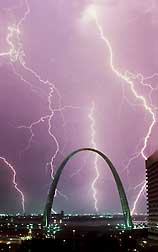 The
sky becomes electric as
The
sky becomes electric as
a large summer thunderstorm
moves over the Gateway Arch,
St. Louis, Missouri
©1980
Joseph Matthews
|
Shooting
lightning is an extension of any photographer’s basic skills and
only standard equipment is required.
You need a good camera capable of some manual adjustment and manual
focus (or be able to lock focus at infinity). Lightning will probably
fool automatic exposure. Auto focus will slow the camera’s response
time. Most point and shot cameras will not work. The camera needs to
be able to fire without excessive vibration. Can you lock the mirror
up? That helps with vibration, as does a cable release. While 35mm cameras
work great, some may want to shoot larger format. Be aware that the
larger the mirror, the slower the response time. Some cameras, like
the Hasselblad, have a prerelease function to smooth out the vibration.
Your film budget will have to be adjusted accordingly! Bottom line,
if your automatic camera has no provision for manual focus and exposure,
your chances of success go down.
You will also need:
- A lot of film. You are going to miss a lot of shots, especially
practicing daytime shot of lightning. If you worry about film cost,
shoot something else. I use transparency film (slide film). It will
let you underexpose a situation and gain color saturation. Color
slide film is what most pros use. Color negative, or print film,
loses contrast in this situation so be prepared to send the film
to a pro lab. The automatic print machine at most one-hour or amateur
labs will give you terrible results. You will think you didn’t
get the shot when what you got was a bad print. The information
is on the film, you will have to fight to get it onto paper.
- A solid tripod (wooden may be preferable if you want to minimize
creating the lightning rod effect. I use metal).
- A cable release for night shots. It won't help with the day time
photos as most releases have a bit of slack in them that will slow
you down. An electronic version for the newer cameras does work
well for both. Don't cheap out, those fall apart and will stop working
properly at the worst times. The cable release will reduce vibration
and let you relax a bit during the exposure. Don't try holding the
shutter open by hand. You'll get tired and start shaking the camera.
- A good handheld exposure meter or high confidence in your camera's
meter.
- For night work, you need a flashlight (maybe two). My second flashlight
has a red lens so I can check camera settings without messing up
my night vision. You'll want the bright white one for set-up and
tear down.
- Again for night work: a timer or stopwatch. You could use your
watch’s second hand. You could also count "One, one thousand,
two, one thousand, three…" At some point, the accuracy
suffers. You can even use a kitchen timer that sets quickly and
beeps to tell you to close the shutter -- handy in the dark.
- A compass will help you track cell movement and wind direction.
- A good map and a highlighter to mark routes.
- A notebook & pencil.
- A reliable car made of metal (plastics and fiberglass are becoming
more common). No convertibles. The idea is to surround yourself
with metal and glass.
- Rain gear for yourself and your camera. Note: If it’s raining
on you, you are too close.
- The cell phone mentioned on the safety page.
You did read the safety page, right?
- Bug repellent, depending on where you are shooting. You may need
people-repellent in some areas.
- Is your trigger finger too slow? Spend the money and get a device
that will trip the shutter for you. The best out there looks like
the The
Lightning Trigger. It's on my wish list when I get some extra
money.
Got a digital camera? Detour through this discussion
of them.
|
